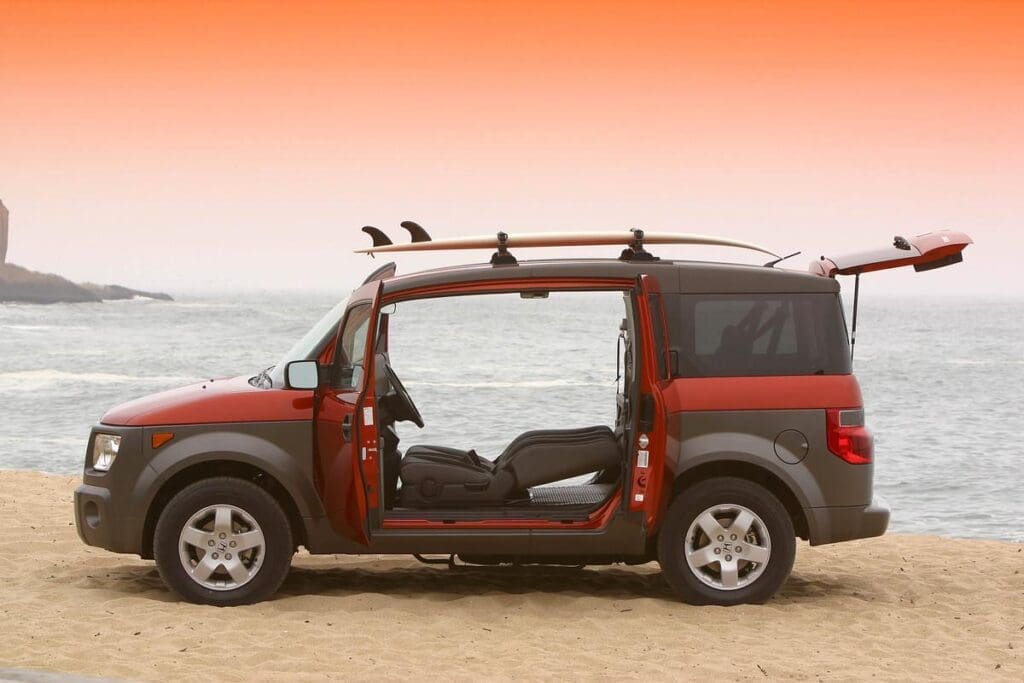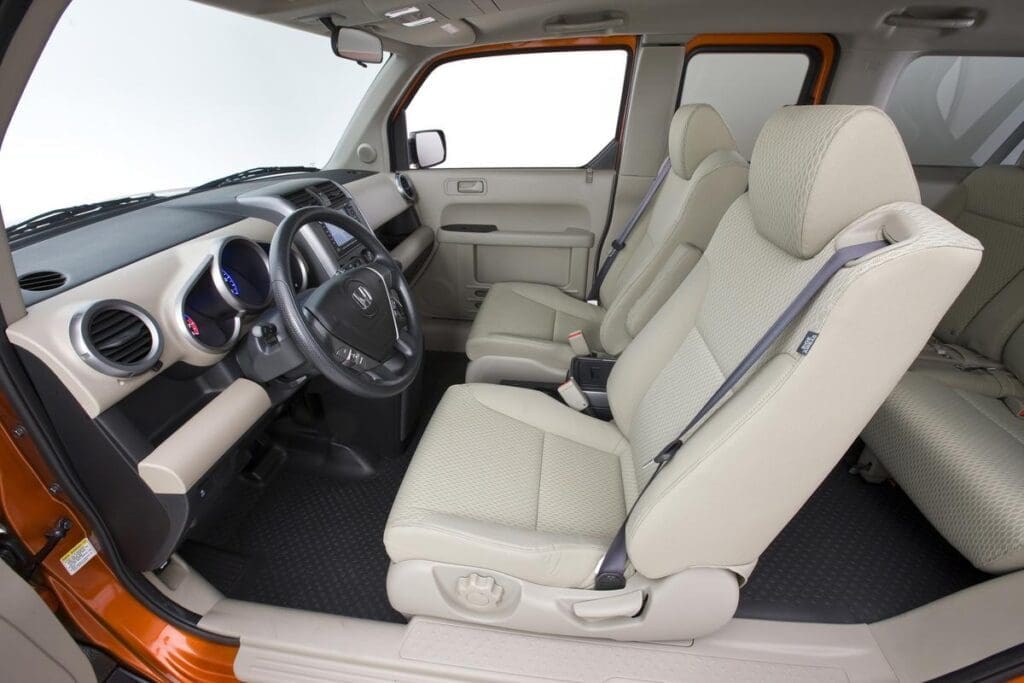The Honda Element is a Used Car Hidden Gem

Contents
Introduction
Produced from 2003 through 2011, the Honda Element is practical, quirky, and unique. It’s also impressively space-efficient. A full eight inches shorter than a Civic, the Element still has enough room inside for four six-footers to ride in comfort thanks to its boxy form and tall cabin. With a pair of smaller, reverse-opening doors next to the front doors and the absence of a “B” pillar, the Element offers a nearly 56-inch-wide opening with all the doors opened up, making it easy to load up passengers or cargo.
As far as styling, the Element is pretty hip for a squared-off form. Honda stated at the press intro that its design was inspired by a beach lifeguard station along with a surfboard, the latter’s influence evident in the curved roofline. They also noted that the Element was geared towards young and active sorts, including campers, dog owners, skiers and snowboarders, and of course surfers. As such, the front and rear ends are comprised of unpainted plastic composite panels, the idea being you don’t have to worry about scratches or dings while exploring the great outdoors.
Yet, despite Honda’s diligent demographic angling, many older folks also have found the Element to be ideal for their lifestyles, which may or may not involve visits to antique shops, wherein the Element’s large portals and tall cabin can swallow up large pieces with ease. Of course, the Element’s elemental all-around goodness factors in as well, contributing to its popularity among the young and old alike.
These qualities, along with its solid Honda engineering, make the Element an excellent used car buy, with outstanding examples available for $10,000 to $15,000.
Engines and Transmissions
Under the Element’s snub nose hood is Honda’s stalwart 2.4-liter inline four that initially made a respectable 156 horsepower. It initially drove the front wheels through a 4-speed automatic or 5-speed manual gearbox. We say initially twice because for 2007 the engine’s output increased to 166 hp and the automatic transmission became a 5-speed unit. All-wheel drive (AWD) was an option that was geared more towards foul-weather driving than serious trail bashing, which was just fine for the Element’s intended buyers. Judging by what we’ve seen, skiers, hikers, and mountain bikers have found the Element capable enough to access their favorite mountains and trailheads.
Road tests of the day, including this one with a second opinion from yours truly, praised the blocky Honda for its spirited acceleration and surprisingly good handling. Indeed, Car and Driver’s long-term test of a 2003 Element with the 5-speed stick had it sprinting to 60 mph in 8.4 seconds and running the quarter in 16.6 seconds. That 5-speed’s shifter, mounted high on the center console and close to hand (as with the automatic), adds to the fun with its (typically Honda) slick and precise action.
Handling is better than expected in light of the Element’s tall architecture and practical leanings. Given that it’s based on the CR-V platform, itself based on the Civic platform, the Element’s confident composure on a curvy road and its firm but not stiff ride over the bumps make it a joy to wheel around.

Features and Options
The Element was first offered in two trim levels – the very basic DX and the well-equipped EX, with buyers choosing between manual or automatic transmissions and front- or all-wheel drive. It has four, not five-passenger capacity due to the two individual rear seats that can be either folded up to the sides or taken out for maximum cargo-hauling duty. A totally flat and waterproof floor, as well as waterproof seats, add to the Element’s versatility and easy cleanup.
Though it does have power windows and locks, the DX is otherwise lacking in desired comfort and luxury features. The EX rectifies that with its generous standard features list that includes alloy wheels, anti-lock brakes, A/C, and a 270-watt AM/FM/CD audio system. Curiously, AWD versions of both trims also come with a removable rear skylight.
As the years went on, a few more trim levels were added, such as the midlevel LX, which bridges the gap between the DX and EX, and the sporty SC (pictured below). The latter is a more pavement-oriented version (AWD was not an option) with larger wheels, a lowered and sport-tuned suspension, a monochromatic paint scheme, and interior upgrades that included a center console, full carpeting, a unique upholstery pattern, and red-on-black instruments.

Model Year Changes
In its first model year, 2003, the Element was offered in the base DX and nicely-equipped EX trim levels mentioned above.
When the 2004 models rolled out, the mid-level LX trim level debuted, giving buyers an agreeable middle ground between a stripper version and one with more bells and whistles than they may have needed. The EX also adopted remote keyless entry as well as the option of side airbags for 2004.
For 2005, the DX was dropped as Honda realized nobody really buys cars without A/C or a stereo anymore. Other highlights for that year include the LX getting a passenger seat armrest, while the EX’s audio system got satellite radio and MP3 capabilities.
Those who liked the Element but not its seemingly unfinished appearance had their gripes addressed for 2006 when a fully-painted version, called the EX-P, debuted.
A mild mid-cycle refresh took place for 2007. Highlights include more power (now 166 hp), another gear for the automatic transmission (now at five speeds), and standard stability control and side airbags for all trims. Also, the front seat belt mounts were relocated, allowing a rear seat passenger to exit without the front passenger having to unbuckle. On the outside, the Element’s grille insert adopted silver slats, and the sporty SC trim level, mentioned earlier, first appeared.

For 2008, nothing notable was new. But for 2009 a navigation system with a rearview camera (pictured above) became available for the EX and SC trim levels. Additionally, the hood and grille were restyled, the skylight was discontinued, the fenders were painted to match the rest of the body, and the wheel wells were squared off. This was also the last year for the manual transmission.
The following year (2010) was uneventful, while for 2011, the Element’s final year, both the SC trim level and the optional navigation system were dropped.
Problem Areas
For the most part, the Honda Element is fairly bulletproof, drawing plenty of praise from its owners. Indeed, over at Edmunds, consumers rate the Element highly, with most model years earning at least 4.7 out of 5 stars, based on hundreds of reviews.
Still, there are a few potential issues to be aware of. According to CarComplaints.com, the three worst Element problems are the speedometer and tachometer needles falling off, the key no longer operating in the doors, and the key no longer operating the ignition. Other areas of concern in the first couple of model years include worn driver’s seat height bushings and defective heater cores and blower motors.
We imagine that by now, over a decade since the last Element was produced, any well-maintained Element that had those issues has had them addressed. Still, these are potential issues you’ll want to check out while you’re checking out used Elements.

Buying Tips
Given its ideal daily driver status, low running costs, and excellent longevity, it’s no wonder that most Element owners have racked up the miles on their versatile vehicles. Throw in the fact that an Element hasn’t rolled off the production line since 2011, and you can understand that finding one without a ton of miles on it can be tough.
That said, there are still some minty fresh, low-mileage examples out there if you dig long and hard enough. Considering the notable powertrain and safety improvements made for 2007, we’d recommend looking at 2007 and newer Elements when you’re shopping for one. However, you still won’t go wrong if you end up finding a nice example that happens to be older than that, as the core goodness is still there.
In a recent search on Autotrader, we found several top-shelf examples that we’d be proud to park in our garages, with miles ranging from about 45,000 to 65,000 and prices ranging from $14,000 to $18,000.

You don’t have to pay that much, though. For $10,000 to $14,000, you can find very well-kept and well-equipped Elements with around 100,000 miles, while good examples with 150,000 miles or more tend to fall in the $6000-$10,000 range. That’s a lot of value for such a versatile and well-made car.
Before you spend ten grand or more on a used Element, we highly recommend hiring a Honda specialist to evaluate it. For about $250, they’ll provide you with a thorough inspection of the entire car. This can reveal major, deal-breaking issues, like hidden damage from an accident, or minor things that you can use as bargaining points, like worn brake pads. Either way, it’s easily worth the money to complete a professional inspection prior to finalizing any used car purchase.
To learn more about finding a good local mechanic, check out our article, How to Find an Auto Mechanic That You Can Trust

The Bottom Line
With its unique styling, incredible space efficiency, spirited performance, excellent handling/ride balance, and low running costs, thanks to respectable fuel economy and a strong reputation for reliability and longevity, the Honda Element makes a strong case for itself. Given all that, it’s not too surprising that Honda’s excellent Element has become something of a cult car.
It’s one cult we’d be happy to join.
Photos courtesy of Honda
